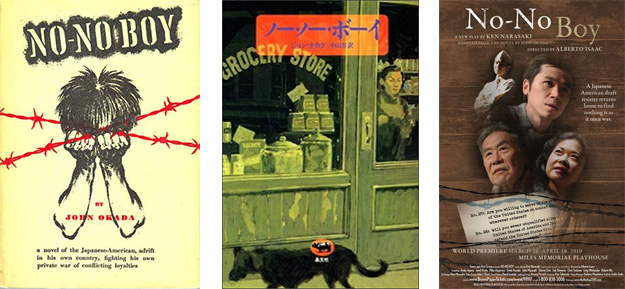 John Okada‘s classic novel, No-No Boy, tells the story of Ichiro Yamada, a fictional version of a real-life “no-no boy.” During World War II, Yamada answered “no” twice in a compulsory government questionnaire as to whether he would serve in the armed forces and swear loyalty to the United States. Unwilling to pledge himself to the country that interned him and his family, Ichiro earned two years in prison and the hostility of his family and community when he returns home to Seattle. As Ruth Ozeki writes in her introduction to the new edition of the book, Ichiro’s “obsessive, tormented” voice subverts Japanese postwar “model-minority” stereotypes, showing a fractured community and one man’s “threnody of guilt, rage, and blame as he tries to negotiate his reentry into a shattered world.”
John Okada‘s classic novel, No-No Boy, tells the story of Ichiro Yamada, a fictional version of a real-life “no-no boy.” During World War II, Yamada answered “no” twice in a compulsory government questionnaire as to whether he would serve in the armed forces and swear loyalty to the United States. Unwilling to pledge himself to the country that interned him and his family, Ichiro earned two years in prison and the hostility of his family and community when he returns home to Seattle. As Ruth Ozeki writes in her introduction to the new edition of the book, Ichiro’s “obsessive, tormented” voice subverts Japanese postwar “model-minority” stereotypes, showing a fractured community and one man’s “threnody of guilt, rage, and blame as he tries to negotiate his reentry into a shattered world.”
First published in 1956, No-No Boy was virtually ignored by a public eager to put World War II and the Japanese internment behind them. It was not until the mid-1970s that a new generation of Japanese American writers and scholars recognized the novel’s importance and popularized it as one of literature’s most powerful testaments to the Asian American experience. In 2014, the University of Washington Press brought out a new edition of the book, with hopes of introducing it to yet another generation of readers. In this guest post, designer Thomas Eykemans discusses his process of creating the cover for this new edition of the book.
No-No Boy is among the most important books that the University of Washington Press publishes. It was vital for me to understand it as best I could before approaching the design of this new reissue. After reading it and learning about its historical context, I did extensive research into past iterations of the book, including a dramatization. It seemed clear that, as historical fiction, an illustration would be the most appropriate approach.

Alternative interpretations of “No-No Boy.” Left to right: the original 1956 jacket design; a 1979 Japanese edition; a poster for a 2010 play adapted from the book.

The 1976 paperback edition of “No-No Boy,” published by UW Press and designed by Koji Onodera. The original cover was printed using four spot colors (black, brown, red, and a tiny bit of blue). Years later, in an effort to reduce printing costs, it was reduced to two colors (black and red). Without the blue ink, the United States flag became unrecognizable, resulting in the oddly unsettling cover that most people are familiar with.
We reached out to Jillian Tamaki, an award-winning contemporary illustrator who teaches at the School of Visual Arts and recently released her second graphic novel. We were impressed with her dramatic and expressive work for clients such as Vintage and the Folio Society, and hoped that she might be able to contribute a fresh interpretation of No-No Boy.
After several rounds of sketches, we settled on a downcast profile of Ichiro overlaid with a bold title. The typeface is a modified Futura, a geometric sans-serif that was ubiquitous in the 1950s and appropriate to the era. The downward diagonals of the “N” and “Y” letterforms intersect the upward angle of the profile, creating a tense visual “X” that pulls the eye to the center before expanding outward. The soft, cool tones of the illustration contrast the intense warmth of the title while also alluding to the national colors of the U.S. and Japanese flags. These elements combine to evoke the deeply conflicted character of Ichiro and his struggles to find his place.



Reblogged this on DAILYBOOKS.ORG and commented:
The University of Washington press recently republished John Okada’s classic novel No-No Boy. In the story, the protagonist, Ichiro Yamada is interned with his family during World War II. When he filled out “a compulsory government questionnaire as to whether he would serve in the armed forces and swear loyalty” he answered no to each of these questions. After answering no, no Yamada was imprisoned for two years. The story follows Yamada after the war as he tries to negotiate his life as a no-no boy. Originally published 1956, the University of Washington is re-introducing this book to American readers. Take a look the post from the University of Washington Press blog to understand why they have re-published this classic work.
Pingback: English 170C: American Literature after 1945 – From No-No Boy to Home Boy (Winter 2015 and Spring 2015) | Susan (Sue) Lewak, Ph.D.